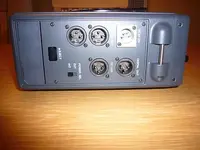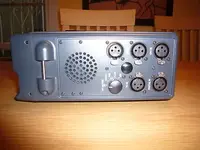N
nsureit
Member
I recently picked this up on eBay - a FOSTEX PD-4M PORTABLE DAT RECORDER.
It is an early 2000's DAT, the kind used to make films, commercials and TV programs at remote locations. Very cool technology. It has a built-in crystal word clock to sync up video and audio. The seller said it was in a storage locker he bought, and he accepted my offer of $400! These are selling today for $1,900 used! What's more incredible is that is was new-in-box. It came in the original box and packing material, and the condition was absolutely pristine.
I am using it to record our band at rehearsals and gigs. I am using 3 pairs of mics through my mixer, and routing them into the 3 input channels on the Fostex.




Item description: (seller's description on eBay)
A few years old, but, never been used.
Originally bought for a movie that was never made.
Taken out of the box for the first time to photograph.
Mint condition.
Comes with Porta Pack.
Two 16-bit digital audio channels.
Four-head design allows confidence monitoring (simultaneous recording and playback) of audio data.
Record and playback capabilities of SMPTE/EBU time code, IECC format.
Compatible with all DAT recorders.
Three sample frequencies: 48 kHz, 48.048 kHz, and 44.1 kHz.
The PD-4 generates time code using a crystal clock. This offers improved flexibility in time code applications, allowing independent operation of the unit.
The internal battery can be replaced without interruption of the internal time code synchronization.
Includes a three channel mixer to enable the recording of voice plus a stereo background at a remote location without having to carry an external mixer.
Each channel of the mixer has a L C R panpot switch, 48V DC phantom power, continuously variable high-pass filter, and 20 dB microphone attenuation.
Full-logic transport to prevent errors in operation.
Digital data transfer using either consumer (SPDIF) or professional (AES/EBU) data formats (IEC 958).
Sound monitoring by stereo headphones or the built-in loudspeaker. The headphone jack switches between the two.
Rugged but lightweight portable construction.
It is an early 2000's DAT, the kind used to make films, commercials and TV programs at remote locations. Very cool technology. It has a built-in crystal word clock to sync up video and audio. The seller said it was in a storage locker he bought, and he accepted my offer of $400! These are selling today for $1,900 used! What's more incredible is that is was new-in-box. It came in the original box and packing material, and the condition was absolutely pristine.
I am using it to record our band at rehearsals and gigs. I am using 3 pairs of mics through my mixer, and routing them into the 3 input channels on the Fostex.




Item description: (seller's description on eBay)
A few years old, but, never been used.
Originally bought for a movie that was never made.
Taken out of the box for the first time to photograph.
Mint condition.
Comes with Porta Pack.
Two 16-bit digital audio channels.
Four-head design allows confidence monitoring (simultaneous recording and playback) of audio data.
Record and playback capabilities of SMPTE/EBU time code, IECC format.
Compatible with all DAT recorders.
Three sample frequencies: 48 kHz, 48.048 kHz, and 44.1 kHz.
The PD-4 generates time code using a crystal clock. This offers improved flexibility in time code applications, allowing independent operation of the unit.
The internal battery can be replaced without interruption of the internal time code synchronization.
Includes a three channel mixer to enable the recording of voice plus a stereo background at a remote location without having to carry an external mixer.
Each channel of the mixer has a L C R panpot switch, 48V DC phantom power, continuously variable high-pass filter, and 20 dB microphone attenuation.
Full-logic transport to prevent errors in operation.
Digital data transfer using either consumer (SPDIF) or professional (AES/EBU) data formats (IEC 958).
Sound monitoring by stereo headphones or the built-in loudspeaker. The headphone jack switches between the two.
Rugged but lightweight portable construction.







